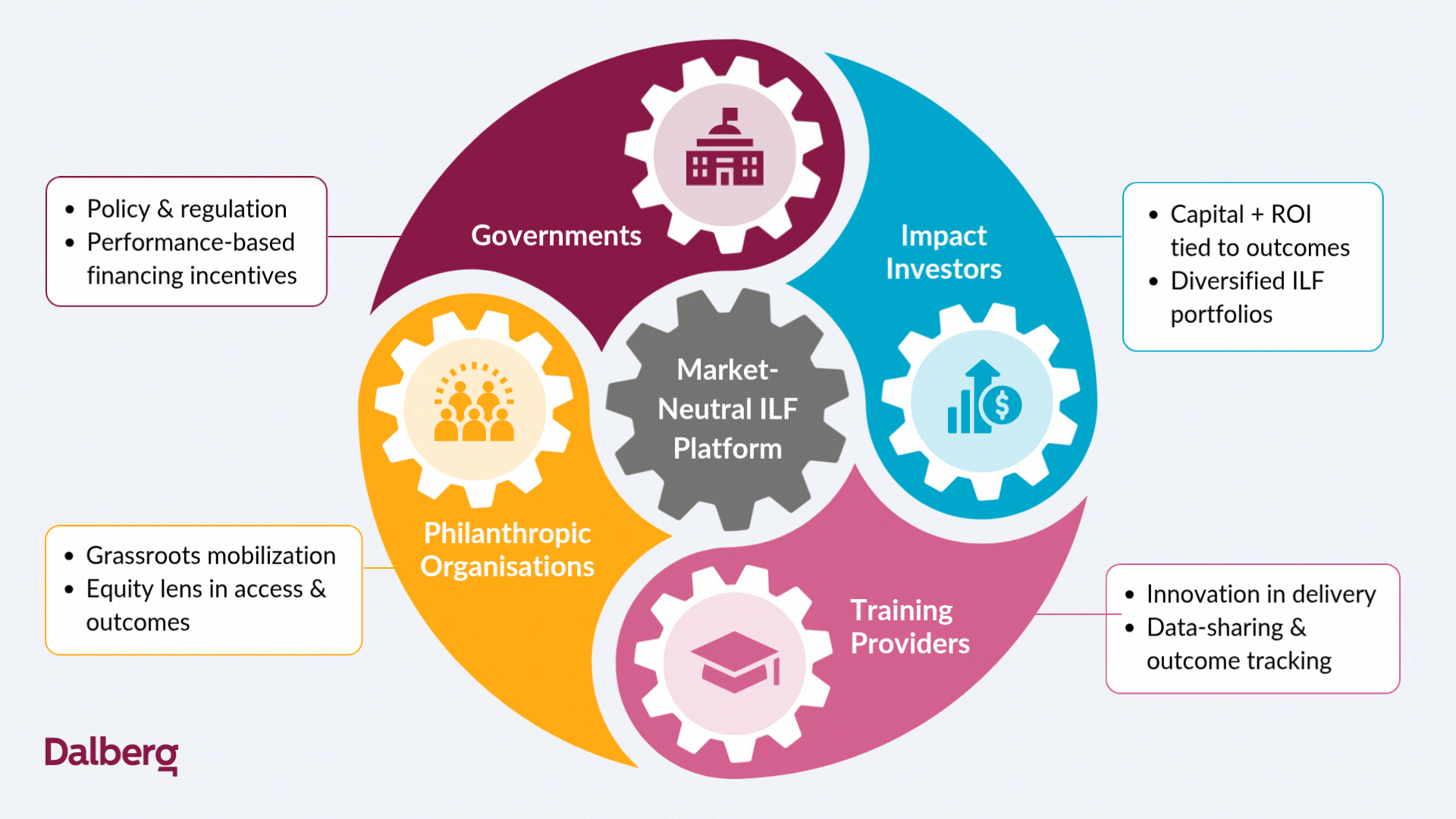Dalberg uses cookies and related technologies to improve the way the site functions. A cookie is a text file that is stored on your device. We use these text files for functionality such as to analyze our traffic or to personalize content. You can easily control how we use cookies on your device by adjusting the settings below, and you may also change those settings at any time by visiting our privacy policy page.
The global energy transition represents a generational opportunity to tackle climate change while spurring economic growth. According to the International Energy Agency (IEA), renewable energy investments have approached $320 billion in 2024, up by more than 50% since 2020.[1] Nations across the globe are positioning themselves to harness this energy transition. However, realizing this opportunity hinges on a critical enabler: a skilled workforce ready to meet the demands of this rapidly evolving sector.
The Skills Gap in the Energy Transition: A Global Workforce Challenge
While the energy transition’s economic potential is undeniable, the demand for a skilled workforce is outpacing the supply. The International Renewable Energy Agency (IRENA) projects that the energy sector will create 42 million jobs by 2050.[2] Yet, from wind turbine technicians to battery engineers, the jobs of the future require specialized expertise that many countries are not yet fully equipped to deliver. In sub-Saharan Africa, renewable energy projects are expanding rapidly, but their current workforce of ~325,000 workers needs the advanced technical skills to scale them effectively.[3] While India is one of the global leaders in renewable energy jobs, with ~1 million total jobs in 2023, the ecosystem that supports the development of the required skillsets for cleantech jobs is nascent.[4] Similarly, Latin America’s growing electric vehicle (EV) market also faces shortages of skilled technicians.[5]
Some countries are moving to address these challenges and set themselves up for success. In Denmark, the skilling journey began decades ago, supported by long-term policy direction and investments in workforce readiness. Denmark’s Energy Technology Development and Demonstration Programme (EUDP) allocated nearly $1 billion across over 1,300 clean energy projects to advance wind technology. Complementing this, vocational training programs like the wind turbine operator course, developed in collaboration with Siemens and Vestas, have ensured a steady pipeline of skilled workers.
Investing in Workforce Development for the Energy Transition
To meet this challenge, enterprises must invest in continuous training programs that are agile enough to keep pace with technological change. Traditional funding models, with fixed repayment structures, often do not account for the dynamic nature of skills development.
Dalberg’s experience with results-based financing such as the Skill Impact Bond in India, which aims to skill over 50,000 young people, offers relevant insights into how outcome-linked models can de-risk training investments and drive impact. While not an ILF mechanism, this work provides transferable lessons for financing skilling in dynamic sectors.
“Just as workforce development must evolve to meet the demands of the energy transition, so must the way we finance it. Impact-Linked Finance provides a simple yet powerful adjustment to conventional financing—rewarding verified outcomes with better terms. By embedding incentives for real-world impact into skilling investments, we can unlock private capital, de-risk innovation, and scale performance-driven models where they are needed most.”
Kusi Hornberger, Partner, Dalberg
ILF: A Potential Game-Changer for Financing Workforce Development
Impact-Linked Finance (ILF) refers to linking financial rewards for market-based organizations to the achievements of positive social outcomes. These rewards can take the form of grant-style incentive payments or impact-adjusted terms for returnable capital (e.g., business loans) where greater impact results in lower cost of capital. Given its focus on commercial enterprises and its use of economic viability as the key lever—both of which distinguish it from other OBF mechanisms—ILF offers a transformative financing solution to the above challenge by aligning financial incentives with measurable social and economic outcomes for enterprises offering skilling.
“The energy transition isn’t just about infrastructure or carbon—it’s a human challenge. A just transition depends on whether we invest not only in clean technologies, but in the people who will power them. From battery engineers to wind technicians, the jobs of tomorrow already exist—but we need bold, impact-linked approaches to ensure that the global workforce is ready.”
Gagandeep Nanda, Associate Partner, Dalberg
One of ILF’s primary strengths is its ability to de-risk innovation. ILF instruments such as Social Impact Incentives (SIINCs) reward training providers for achieving specific outcomes, such as higher job placement rates or increased wages for skilled workers. This makes workforce skilling initiatives financially viable and scalable, especially for enterprises hesitant to invest in untested training programs. In Latin America, SIINCs have supported providers in delivering better outcomes for underserved populations, with payments tied to measurable improvements in access and health indicators.[6] Impact-Linked Loans are another ILF instrument, in which repayment obligations are tied to borrowers’ achievement of predefined and independently verified social outcomes. The Impact-Linked Fund for Education for instance provides favorable loan terms to organizations that work towards improving access to quality education for vulnerable children and youth across MENA and West Africa.[7]
Additionally, unlike traditional funding models, ILF structures financing around performance-based metrics, ensuring that investments directly contribute to job creation, skill development, and long-term workforce sustainability. ILF enhances transparency and accountability by linking financial support to concrete milestones, such as certification completion rates, job placements, and salary increases. This ensures that funding is not just allocated, but also delivers tangible impact, creating a self-reinforcing cycle of investment, skill-building, and economic growth.
While ILF-skilling mechanisms are still nascent, Dalberg’s broader work in results-based finance offers valuable insights. We have found that incentives that are simple, transparent, and linked to outcomes like higher certification or wage gains can encourage innovation and scale. This is further validated by other ecosystem efforts. For example, Roots of Impact, with support from the Impact-Linked Fund for Education, implemented a SIINC with Sprints. Sprints, an AI-powered EdTech enterprise training underserved African youth in high-demand tech skills, received outcome-based payments for improving technical proficiency, boosting job placements, and increasing female participation. This embedded equity into its business model while expanding impact.
A parallel lesson comes from ILF Collaborative, a scoping effort to understand stakeholder perspectives and barriers to wider adoption. The ILF Collaborative aims to build an enabling environment through shared standards, evidence generation, and advocacy. Across both our programmatic work and the Collaborative, a consistent principle stands out: that clear, well-defined performance targets can de-risk new initiatives and build confidence among hesitant participants. By establishing a centralized evidence base, clarifying standards, and aligning incentives, our experience with the ILF Collaborative reinforces the value of simple yet effective structures.
The Energy Transition is Not Just an Environmental Imperative; It is a Socio-Economic One.
Without a workforce equipped to drive this shift, nations risk leaving millions behind, exacerbating inequality, and hindering global climate progress. Impact-Linked Finance offers a pathway to bridge the skills gap by aligning financial incentives with measurable outcomes. Through our work at Dalberg, we have observed that these models align the interests of investors, training institutions, and beneficiaries—ensuring that investments lead directly to job creation, skill acquisition, and long-term economic growth. Furthermore, the clarity and accountability inherent in ILF mechanisms attract a more diverse set of funders—including private investors and philanthropic organizations—broadening the pool of capital available to drive this crucial transformation. This model represents a game-changer for financing workforce development, offering a scalable solution that can drive a just transition globally.
ILF holds transformative potential—but unlocking this potential requires immediate, coordinated action and a clear strategy for scaling. Our recent scoping work on the ILF Collaborative has provided early insights into the foundational steps needed to expand ILF transactions. It revealed that scaling these innovative financing mechanisms goes beyond a promising concept—it demands the creation of a market-neutral platform where governments, impact investors, training providers, and philanthropic organizations work together around shared, standardized performance metrics. To advance this vision, governments must craft supportive policies that incentivize performance-based financing; impact investors need to broaden their portfolios to include ILF instruments that reward measurable social outcomes; training providers should embrace continuous innovation; and philanthropic organizations can mobilize grassroots support to ensure the approach benefits all communities.

By uniting these efforts under a common framework and building a centralized evidence base to de-risk and legitimize ILF models, every dollar invested can drive tangible social and economic progress, powering the energy transition, creating meaningful employment, and fostering global prosperity.
[1] International Energy Agency, World Energy Investment, 2024
[2] World Bank, The Employment Benefits of Energy Transition in Egypt, 2022
[3] Reuters, How bridging the skills gap can boost Africa’s green energy transition, 2024; IRENA, Highest Annual Growth of Renewables Jobs in 2023, Reaching 16.2 Million, 2024
[4] Skills Council for Green Jobs, Gearing up the Indian Workforce for a Green Economy, 2023; Ministry of New and Renewable Energy, India’s Renewable Energy Boom: Job Creation and Sustainable Growth, 2024
[5] Bloomberg, Nearshoring In Latin America Faces Challenge of Technical Talent Deficit, 2023
[6] Roots of Impact, Empowering Clínicas Del Azúcar To Attract Investment And Create Impact At Scale Case Study After Final Results, 2020
[7] Impact Linked Finance Fund, Press Release, 2021
To learn more about our work on impact-linked approaches for workforce development in the energy transition, contact:



